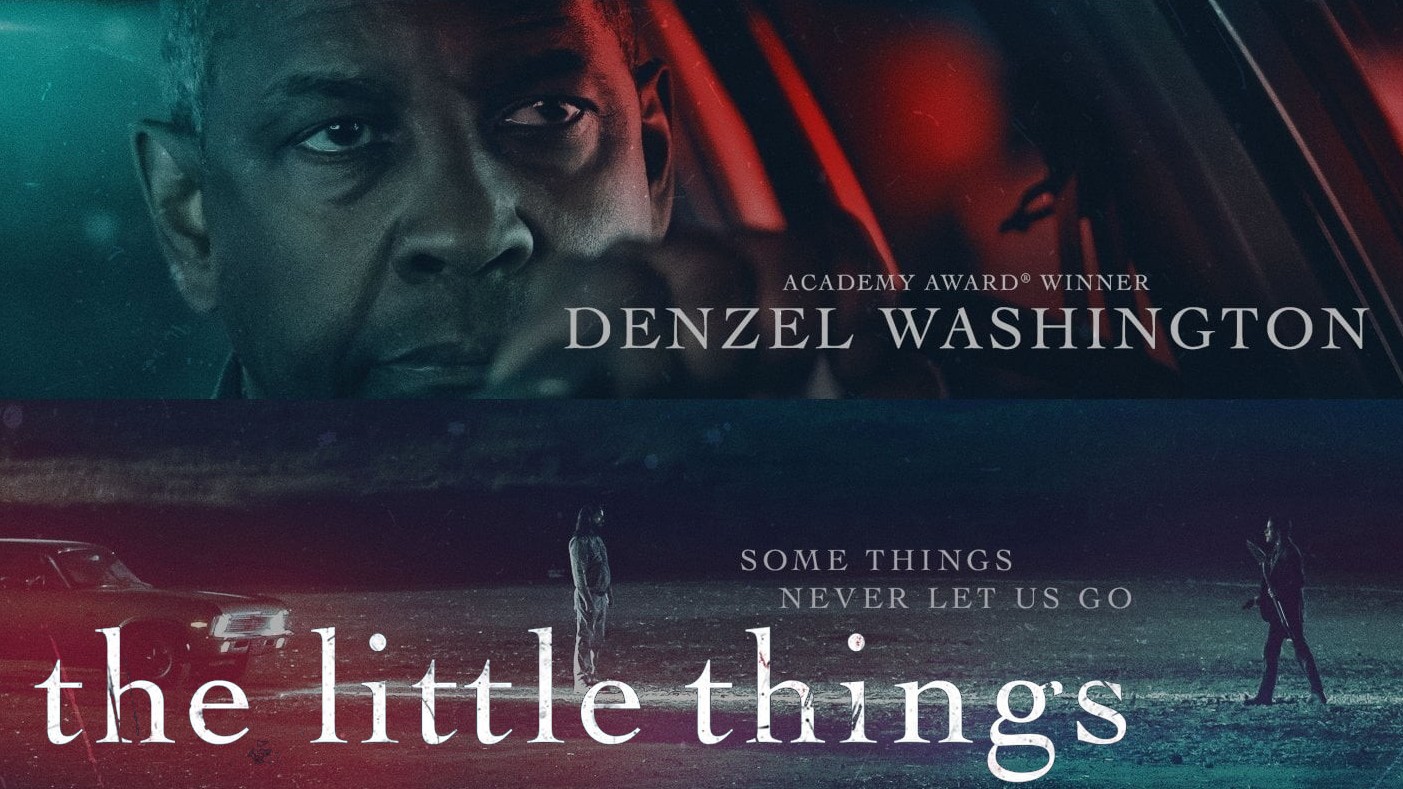Where to Watch The Little Things 2021 Full Movie Online Free? [DVD-ENGLISH] The Little Things (2021) Full Movie Watch online free HQ [DvdRip-USA eng subs ]] The Little Things! (2021) Full Movie Watch # The Little Things online free 123 Movies Online !! The Little Things (2021) | Watch The Little Things Online (2021) Full Movie Free HD.720Px|Watch The Little Things Online (2021) Full MovieS Free HD Google Drive!!
The Little Things (2021) with English Subtitles ready for download, The Little Things (2021) 720p, 1080p, BrRip, DvdRip, High Quality. Kern County Deputy Sheriff Joe “Deke” Deacon is sent to Los Angeles for what should have been a quick evidence-gathering assignment. Instead, he becomes embroiled in the search for a killer who is terrorizing the city.
Leading the hunt, L.A. Sheriff Department Sergeant Jim Baxter, impressed with Deke’s cop instincts, unofficially engages his help. But as they track the killer, Baxter is unaware that the investigation is dredging up echoes of Deke’s past, uncovering disturbing secrets that could threaten more than his case. The Little Things is a 2021 American neo-noir crime thriller film written and directed by John Lee Hancock, and produced by Hancock and Mark Johnson. The plot follows two police officers (Denzel Washington and Rami Malek) who try to catch a serial killer in Los Angeles, when they find a strange man (Jared Leto) who becomes their top suspect.
The Little Things was released in the United States on January 29, 2021 by Warner Bros. Pictures, as well as a month-long simultaneous release on the HBO Max streaming service. The film received mixed reviews. ◇ STREAMING MEDIA ◇ Streaming media is multimedia that is constantly received by and presented to an end-user while being delivered by a provider.
The verb to stream refers to the process of delivering or obtaining media in this manner.[clarification needed] Streaming refers to the delivery method of the medium, rather than the medium itself. Distinguishing delivery method from the media distributed applies specifically to telecommunications networks, as most of the delivery systems are either inherently streaming (e.g. radio, television, streaming apps) or inherently non-streaming (e.g. books, video cassettes, audio CDs). There are challenges with streaming content on the Internet. For example, users whose Internet connection lacks sufficient bandwidth may experience stops, lags, or slow buffering of the content. And users lacking compatible hardware or software systems may be unable to stream certain content.
CLICK TO WATCH THE LITTLE THINGS
Live streaming is the delivery of Internet content in real-time much as live television broadcasts content over the airwaves via a television signal. Live internet streaming requires a form of source media (e.g. a video camera, an audio interface, screen capture software), an encoder to digitize the content, a media publisher, and a content delivery network to distribute and deliver the content. Live streaming does not need to be recorded at the origination point, although it frequently is.
Streaming is an alternative to file downloading, a process in which the end-user obtains the entire file for the content before watching or listening to it. Through streaming, an end-user can use their media player to start playing digital video or digital audio content before the entire file has been transmitted. The term “streaming media” can apply to media other than video and audio, such as live closed captioning, ticker tape, and real-time text, which are all considered “streaming text”. Elevator music was among the earliest popular music available as streaming media; nowadays Internet television is a common form of streamed media. Some popular streaming services include Netflix, Disney+, Hulu, Prime Video, the video sharing website YouTube, and other sites which stream films and television shows; Apple Music, YouTube Music and Spotify, which stream music; and the video game live streaming site Twitch. ◇ COPYRIGHT ◇ Copyright is a type of intellectual property that gives its owner the exclusive right to make copies of a creative work, usually for a limited time.
The creative work may be in a literary, artistic, educational, or musical form. Copyright is intended to protect the original expression of an idea in the form of a creative work, but not the idea itself. A copyright is subject to limitations based on public interest considerations, such as the fair use doctrine in the United States. Some jurisdictions require “fixing” copyrighted works in a tangible form. It is often shared among multiple authors, each of whom holds a set of rights to use or license the work, and who are commonly referred to as rights holders. [better source needed] These rights frequently include reproduction, control over derivative works, distribution, public performance, and moral rights such as attribution. Copyrights can be granted by public law and are in that case considered “territorial rights”.
This means that copyrights granted by the law of a certain state, do not extend beyond the territory of that specific jurisdiction. Copyrights of this type vary by country; many countries, and sometimes a large group of countries, have made agreements with other countries on procedures applicable when works “cross” national borders or national rights are inconsistent. Typically, the public law duration of a copyright expires 50 to 100 years after the creator dies, depending on the jurisdiction. Some countries require certain copyright formalities to establishing copyright, others recognize copyright in any completed work, without a formal registration.
In general, many believe that the long copyright duration guarantees the better protection of works. However, several scholars argue that the longer duration does not improve the author’s earnings while impeding cultural creativity and diversity. On the contrast, a shortened copyright duration can increase the earnings of authors from their works and enhance cultural diversity and creativity. ◇ MOVIES or FILM ◇ Movies, or films, are a type of visual communication which uses moving pictures and sound to tell stories or teach people something. Most people watch (view) movies as a type of entertainment or a way to have fun. For some people, fun movies can mean movies that make them laugh, while for others it can mean movies that make them cry, or feel afraid. It is widely believed that copyrights are a must to foster cultural diversity and creativity.
However, Parc argues that contrary to prevailing beliefs, imitation and copying do not restrict cultural creativity or diversity but in fact support them further. This argument has been supported by many examples such as Millet and Van Gogh, Picasso, Manet, and Monet, etc. Most movies are made so that they can be shown on screen in Cinemas and at home.
After movies are shown in Cinemas for a period of a few weeks or months, they may be marketed through several other medias. They are shown on pay television or cable television, and sold or rented on DVD disks or videocassette tapes, so that people can watch the movies at home. You can also download or stream movies. Older movies are shown on television broadcasting stations. A movie camera or video camera takes pictures very quickly, usually at 24 or 25 pictures (frames) every second.
When a movie projector, a computer, or a television shows the pictures at that rate, it looks like the things shown in the set of pictures are really moving. Sound is either recorded at the same time, or added later. The sounds in a movie usually include the sounds of people talking (which is called dialogue), music (which is called the “soundtrack”), and sound effects, the sounds of activities that are happening in the movie (such as doors opening or guns being fired). In the 20th century the camera used photographic film. The product is still often called a “film” even though there usually is no film. A genre is a word for a type of movie or a style of movie. Movies can be fictional (made up), or documentary (showing ‘real life’), or a mix of the two. Although hundreds of movies are made every year, there are very few that do not follow a small number of set plots, or stories. Some movies mix together two or more genres.
Action movies have a lot of exciting effects like car chases and gun fights, involving stuntmen. They usually involve ‘goodies’ and ‘baddies’, so war and crime are common subjects. Action movies usually need very little effort to watch, since the plot is normally simple. For example, in Die Hard, terrorists take control of a skyscraper and ask for a big ransom in exchange for not killing the hostage workers. One hero somehow manages to save everyone. Action movies do not usually make people cry, but if the action movie is also a drama, emotion will be involved. Adventure Movies usually involve a hero who sets out on a quest to save the world or loved ones. Animated movies use artificial images like talking cartoons to tell a story.
These movies used to be drawn by hand, one frame at a time, but are now made on computers. Buddy movies involve 2 heroes, one must save the other, both must overcome obstacles. Buddy movies often involve comedy, but there is also some emotion, because of the close friendship between the ‘buddies’. Comedies are funny movies about people being silly or doing unusual things or being in silly or unusual situations that make the audience laugh. Documentaries are movies that are (or claim to be) about real people and real events. They are nearly always serious and may involve strongly emotional subjects, for example cruelty. Dramas are serious, and often about people falling in love or needing to make a big decision in their life. They tell stories about relationships between people.
They usually follow a basic plot where one or two main characters (each actor plays a character) have to ‘overcome’ (get past) an obstacle (the thing stopping them) to get what they want. Tragedies are always dramas, and are about people in trouble. For example, a husband and wife who are divorcing must each try to prove to a court of law that they are the best person to take care of their child. Emotion (feelings) are a big part of the movie and the audience (people watching the movie) may get upset and even cry. Film noir movies are 1940s-era detective dramas about crime and violence. Family movies are made to be good for the entire family. They are mainly made for children but often entertaining for adults as well.
Disney is famous for their family movies. Horror movies use fear to excite the audience. Music, lighting and sets (man-made places in movie studios where the movie is made) are all designed to add to the feeling. Romantic Comedies (Rom-Coms) are usually love stories about 2 people from different worlds, who must overcome obstacles to be together. Rom-Coms are usually light-hearten, but may include some emotion. Comedy horror movies blend horror and comic motifs in its plots. Movies in this genre sometimes use black comedy as the main form of humor. Science fiction movies are set in the future or in outer space. Some use their future or alien settings to ask questions about the meaning of life or how we should think about life. Science fiction movies often use special effects to create images of alien worlds, outer space, alien creatures, and spaceships. Fantasy movies include magical and impossible things that any real human being cannot do. Thrillers are usually about a mystery, strange event, or crime that needs to be solved.
The audience is kept guessing until the final minutes, when there are usually ‘twists’ in the plot (surprises). Suspense movies keep you on the edge of your seat. They usually have multiple twists that confuse the watcher. Western movies tell stories about cowboys in the western United States in the 1870s and 1880s. They are usually action movies, but with historical costumes. Some involve Native Americans. Not all films that are set in the American West are made there. For example, Western films made in Italy are called Spaghetti Westerns. Some films can also use Western plots even if they are set in other places.



